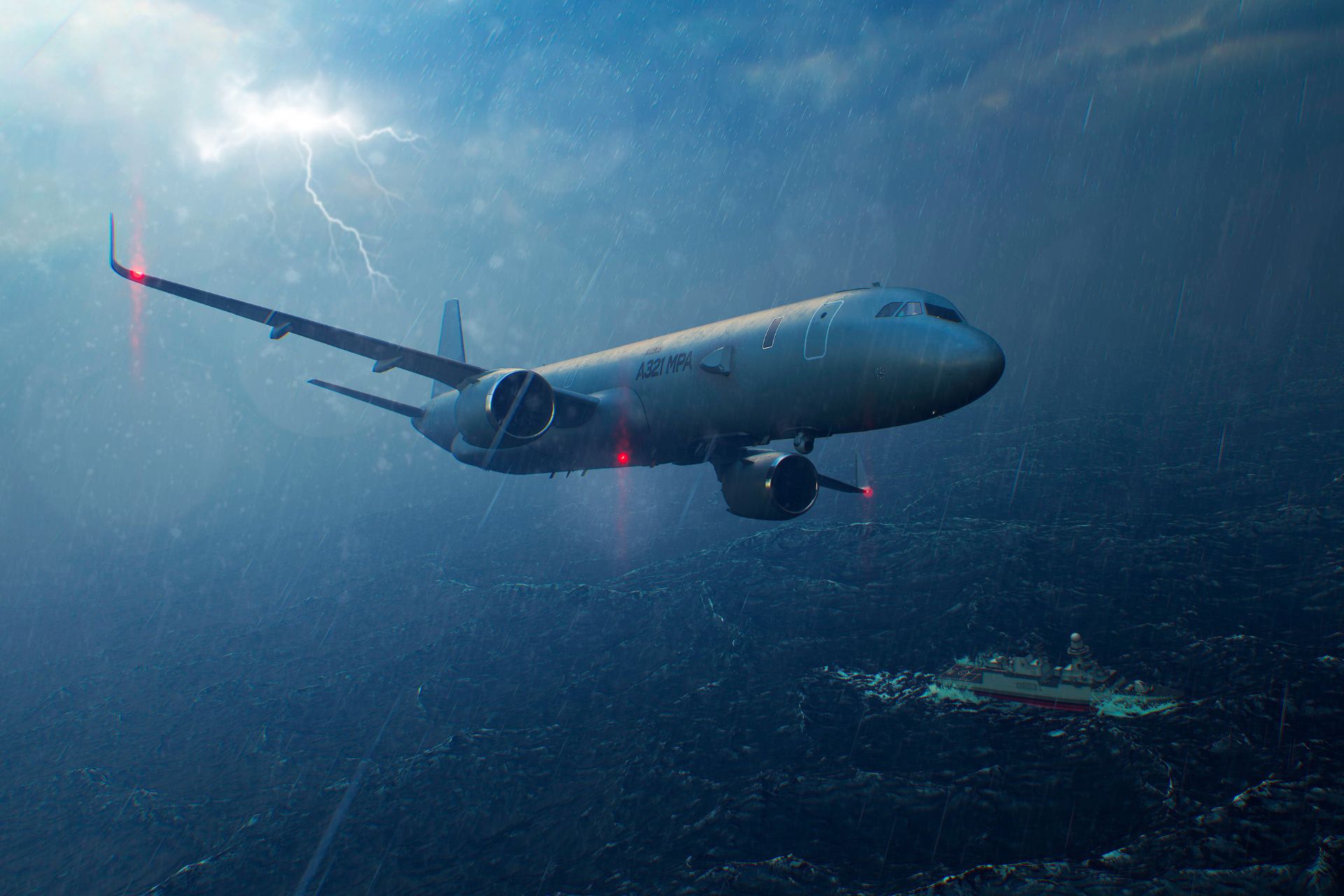France’s Future Maritime Patrol Aircraft Takes Shape as Airbus Advances A321 MPA

{loadposition bannertop}
{loadposition sidebarpub}
On February 4, 2025, Airbus announced that the French Defence Procurement Agency (DGA) had awarded Airbus Defence and Space a contract for a risk assessment and definition study for France’s future maritime patrol aircraft program. This 24-month study follows the architecture and feasibility study initiated at the end of 2022. Airbus, as the prime contractor, is leading the project in partnership with Thales, to refine the program’s economic and industrial framework while preparing for technical decisions and initial aerodynamic tests.
Follow Army Recognition on Google News at this link
The A321 MPA is also equipped with advanced communication systems, including satellite links, ensuring enhanced interoperability with other military and naval platforms (Picture source: Airbus)
The study aims to lay the groundwork for the development and production launch of a new maritime patrol aircraft, expected to begin at the end of 2026. The A321 MPA (Maritime Patrol Aircraft) is a military adaptation of the Airbus A321XLR, designed to meet the French Navy’s requirements, particularly in anti-submarine and anti-ship warfare, as well as intelligence gathering. Intended to replace the fleet of Atlantique 2 aircraft currently based at the Lann-Bihoué Naval Air Base, the new aircraft is scheduled to enter service between 2030 and 2040.
The Airbus A321 MPA stands out for its extended range and advanced operational capabilities. Designed to cover large maritime areas, it offers an increased operational radius due to its higher fuel capacity compared to other aircraft in its category. Its open architecture and large weapons bay provide significant flexibility for carrying mission-specific equipment. The aircraft is equipped with state-of-the-art sensors, including an advanced active electronically scanned array (AESA) radar, a magnetic anomaly detector (MAD), electronic support measures (ESM), and an acoustic system utilizing passive and active sonar buoys. This sensor suite enhances surveillance capabilities, improving detection and engagement effectiveness.
The A321 MPA is also equipped with advanced communication systems, including satellite links, ensuring enhanced interoperability with other military and naval platforms. Its weaponry is specifically designed for anti-submarine and anti-ship warfare, with the capability to deploy torpedoes and the future anti-ship missile (FMAN). Derived from the A321 family, the aircraft benefits from a large payload capacity while maintaining simplified maintenance and optimized operating costs, key advantages for armed forces operations.
The development of the A321 MPA aligns with a broader strategic approach to meet the increasing demand for maritime surveillance and security. Airbus highlights the logistical benefits of integrating the aircraft into fleets already operating A320 family aircraft, minimizing additional infrastructure and training requirements. The company also leverages its proven expertise in converting commercial aircraft into military platforms, demonstrated by the success of the A330 Multi Role Tanker Transport (MRTT), which leads the global market for tanker aircraft outside the United States. Airbus also has extensive experience in integrating mission systems on aircraft such as the P3, C295, and CN235, with over 170 units currently in service for maritime surveillance missions.
The A321 MPA directly competes with the Boeing P-8 Poseidon, which is currently in service with major navies, including those of the United States, India, and Australia. Airbus emphasizes a more modern design, improved fuel efficiency, and reduced operational costs to attract military operators seeking a next-generation aircraft. At the same time, Airbus continues to promote the C295 Persuader as a more cost-effective solution for lower-intensity maritime patrol missions, though its range and capabilities remain more limited due to its size.
With this new study, Airbus and its partners are progressing toward the realization of a strategic program for French defense. The A321 MPA aims to become a central element of maritime patrol operations, contributing to the oceanic component of nuclear deterrence. This program reflects the evolving requirements for maritime surveillance and France’s objective of maintaining sovereign capabilities in response to future security challenges.

{loadposition bannertop}
{loadposition sidebarpub}
On February 4, 2025, Airbus announced that the French Defence Procurement Agency (DGA) had awarded Airbus Defence and Space a contract for a risk assessment and definition study for France’s future maritime patrol aircraft program. This 24-month study follows the architecture and feasibility study initiated at the end of 2022. Airbus, as the prime contractor, is leading the project in partnership with Thales, to refine the program’s economic and industrial framework while preparing for technical decisions and initial aerodynamic tests.
The A321 MPA is also equipped with advanced communication systems, including satellite links, ensuring enhanced interoperability with other military and naval platforms (Picture source: Airbus)
The study aims to lay the groundwork for the development and production launch of a new maritime patrol aircraft, expected to begin at the end of 2026. The A321 MPA (Maritime Patrol Aircraft) is a military adaptation of the Airbus A321XLR, designed to meet the French Navy’s requirements, particularly in anti-submarine and anti-ship warfare, as well as intelligence gathering. Intended to replace the fleet of Atlantique 2 aircraft currently based at the Lann-Bihoué Naval Air Base, the new aircraft is scheduled to enter service between 2030 and 2040.
The Airbus A321 MPA stands out for its extended range and advanced operational capabilities. Designed to cover large maritime areas, it offers an increased operational radius due to its higher fuel capacity compared to other aircraft in its category. Its open architecture and large weapons bay provide significant flexibility for carrying mission-specific equipment. The aircraft is equipped with state-of-the-art sensors, including an advanced active electronically scanned array (AESA) radar, a magnetic anomaly detector (MAD), electronic support measures (ESM), and an acoustic system utilizing passive and active sonar buoys. This sensor suite enhances surveillance capabilities, improving detection and engagement effectiveness.
The A321 MPA is also equipped with advanced communication systems, including satellite links, ensuring enhanced interoperability with other military and naval platforms. Its weaponry is specifically designed for anti-submarine and anti-ship warfare, with the capability to deploy torpedoes and the future anti-ship missile (FMAN). Derived from the A321 family, the aircraft benefits from a large payload capacity while maintaining simplified maintenance and optimized operating costs, key advantages for armed forces operations.
The development of the A321 MPA aligns with a broader strategic approach to meet the increasing demand for maritime surveillance and security. Airbus highlights the logistical benefits of integrating the aircraft into fleets already operating A320 family aircraft, minimizing additional infrastructure and training requirements. The company also leverages its proven expertise in converting commercial aircraft into military platforms, demonstrated by the success of the A330 Multi Role Tanker Transport (MRTT), which leads the global market for tanker aircraft outside the United States. Airbus also has extensive experience in integrating mission systems on aircraft such as the P3, C295, and CN235, with over 170 units currently in service for maritime surveillance missions.
The A321 MPA directly competes with the Boeing P-8 Poseidon, which is currently in service with major navies, including those of the United States, India, and Australia. Airbus emphasizes a more modern design, improved fuel efficiency, and reduced operational costs to attract military operators seeking a next-generation aircraft. At the same time, Airbus continues to promote the C295 Persuader as a more cost-effective solution for lower-intensity maritime patrol missions, though its range and capabilities remain more limited due to its size.
With this new study, Airbus and its partners are progressing toward the realization of a strategic program for French defense. The A321 MPA aims to become a central element of maritime patrol operations, contributing to the oceanic component of nuclear deterrence. This program reflects the evolving requirements for maritime surveillance and France’s objective of maintaining sovereign capabilities in response to future security challenges.




